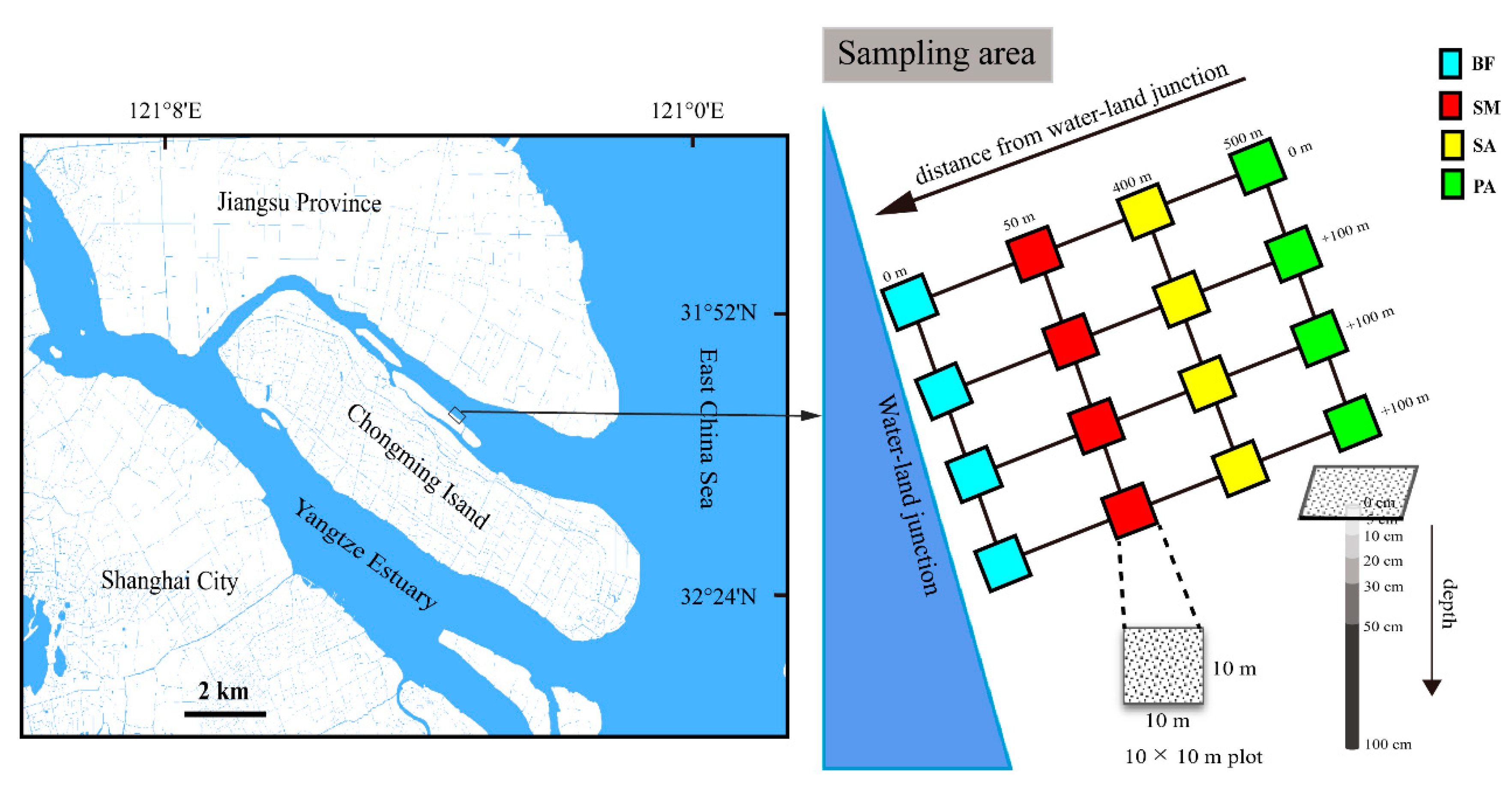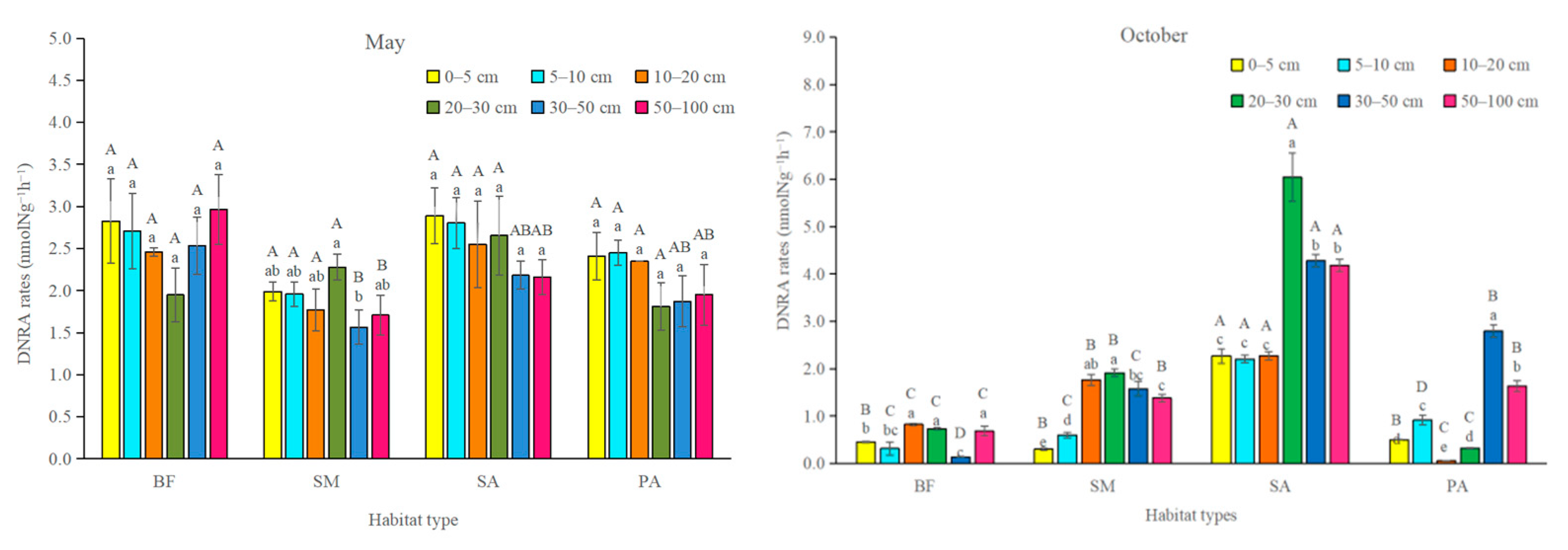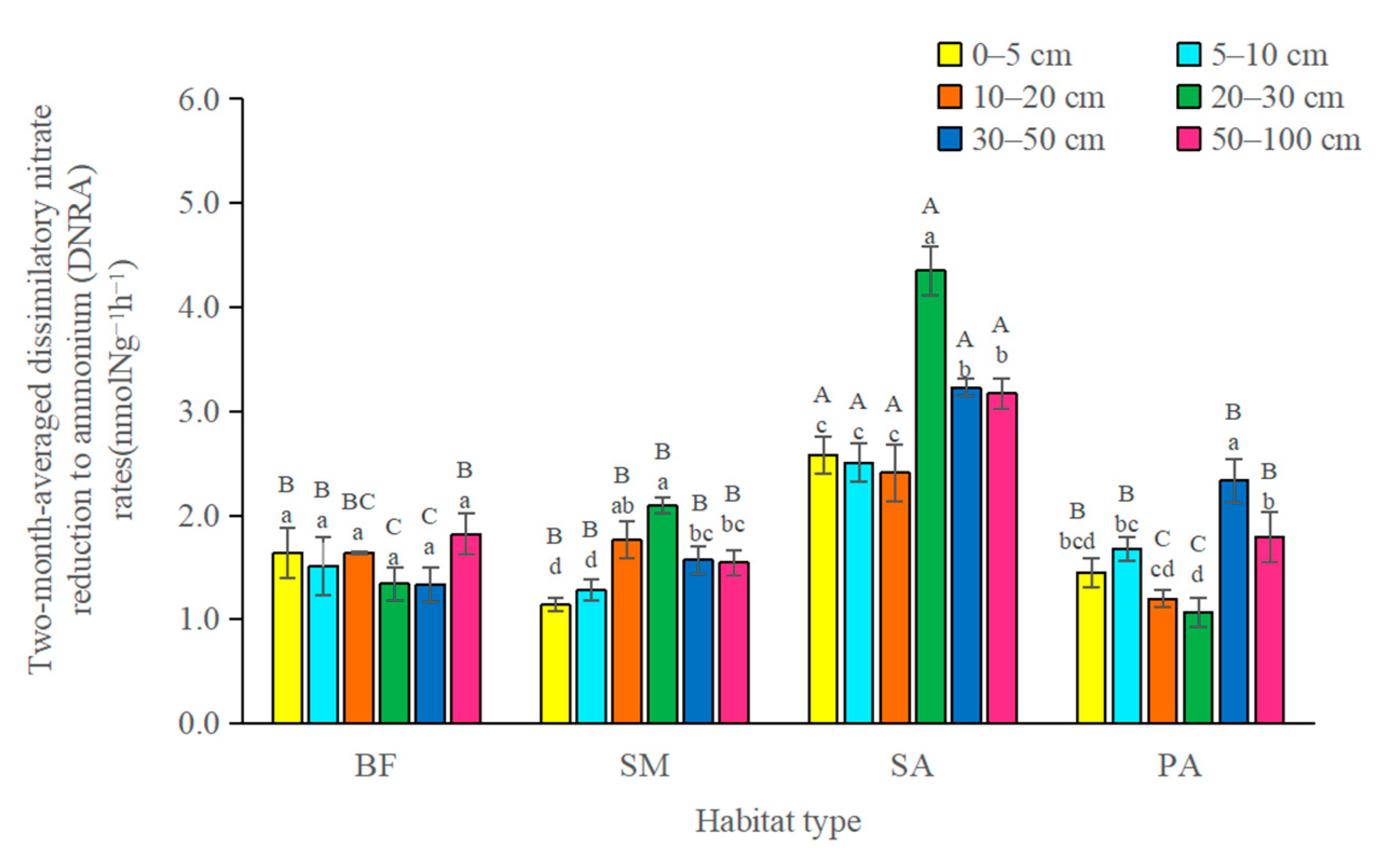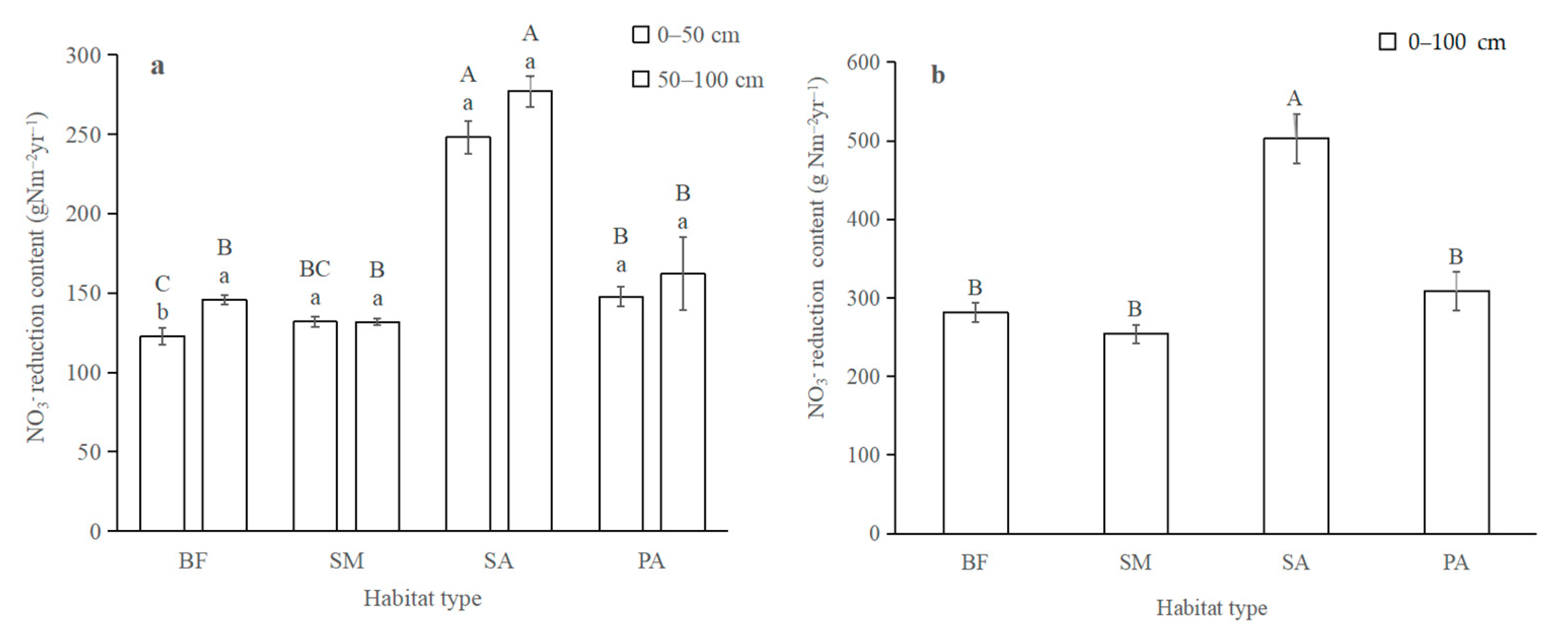Spartina alterniflora Invasion Enhances Dissimilatory Nitrate Reduction to Ammonium (DNRA) Rates in the Yangtze River Estuary, China
Abstract
:1. Introduction
2. Materials and Methods
2.1. Study Site and Experimental Design
2.2. Sample Collection
2.3. Analysis of Soil Characteristics
2.4. Measurement of the DNRA Rates
2.5. Statistical Analysis
3. Results
3.1. Potential Rates of DNRA
3.2. NO3− Reduction Content
3.3. Influences of Soil Variables on Potential Rates of DNRA
4. Discussion
5. Conclusions
Supplementary Materials
Author Contributions
Funding
Acknowledgments
Conflicts of Interest
References
- Fock, H.O. Changes in the Seasonal Cycles of Inorganic Nutrients in the Coastal Zone of the Southeastern North Sea from 1960 to 1997: Effects of Eutrophication and Sensitivity to Meteoclimatic Factors. Mar. Pollut. Bull. 2003, 46, 1434–1449. [Google Scholar] [CrossRef]
- Fang, Y.; Gundersen, P.; Mo, J.; Zhu, W. Nitrogen Leaching in Response to Increased Nitrogen Inputs in Subtropical Monsoon Forests in Southern China. For. Ecol. Manag. 2009, 257, 332–342. [Google Scholar] [CrossRef]
- Lin, X.B.; Liu, M.; Hou, L.J.; Gao, D.Z.; Li, X.F.; Lu, K.J.; Gao, J. Nitrogen Losses in Sediments of the East China Sea: Spatiotemporal Variations, Controlling Factors, and Environmental Implications. J. Geophys. Res. Biogeosci. 2017, 122, 2699–2715. [Google Scholar] [CrossRef]
- Jiang, Y.; Yin, G.; Li, Y.; Hou, L.; Liu, M.; Chen, C.; Zheng, D.; Wu, H.; Gao, D.; Zheng, Y.; et al. Saltwater Incursion Regulates N2O Emission Pathways and Potential Nitrification and Denitrification in Intertidal Wetland. Biol. Fertil. Soils 2022, 12, 234–245. [Google Scholar] [CrossRef]
- Lin, X.B.; Zheng, P.F.; Zou, S.B.; Sun, F.F.; Zhang, X.L.; Gong, J. Seagrass (Zostera marina) Promotes Nitrification Potential and Selects Specific Ammonia Oxidizers in Coastal Sediments. J. Soils Sediments 2021, 21, 3259–3273. [Google Scholar] [CrossRef]
- Wei, H.C.; Lin, X.B. Shifts in the Relative Abundance and Potential Rates of Sediment Ammonia-oxidizing Archaea and Bacteria along Environmental Gradients of an Urban River-estuary-adjacent Sea Continuum. Sci. Total Environ. 2021, 771, 144824. [Google Scholar] [CrossRef]
- Cheng, Y.; Elrys, A.S.; Merwad, A.R.M.A.; Zhang, H.; Chen, Z.; Zhang, J.; Cai, Z.C.; Müller, C. Global Patterns and Drivers of Soil Dissimilatory Nitrate Reduction to Ammonium. Environ. Sci. Technol. 2022, 56, 3791–3800. [Google Scholar] [CrossRef]
- Pandey, C.B.; Kumar, U.; Kaviraj, M.; Minick, K.J.; Mishra, A.; Singh, J.S. DNRA: A Short-Circuit in Biological N-Cycling to Conserve Nitrogen in Terrestrial Ecosystems. Sci. Total Environ. 2020, 738, 139710. [Google Scholar] [CrossRef]
- Huang, F.J.; Lin, X.B.; Hu, W.F.; Zeng, F.; He, L.; Yin, K.D. Nitrogen Cycling Processes in Sediments of the Pearl River Estuary: Spatial Variations, Controlling Factors, and Environmental Implications. Catena 2021, 206, 105545. [Google Scholar] [CrossRef]
- Huang, F.J.; Lin, X.B.; Yin, K.D. Effects of Marine Produced Organic Matter on the Potential Estuarine Capacity of NOx− Removal. Sci. Total Environ. 2022, 812, 151471. [Google Scholar] [CrossRef]
- Wei, H.C.; Gao, D.Z.; Liu, Y.; Lin, X.B. Sediment nitrate reduction processes in response to environmental gradients along an urban river-estuary-sea continuum. Sci. Total Environ. 2020, 718, 137185. [Google Scholar] [CrossRef] [PubMed]
- Minick, K.J.; Pandey, C.B.; Fox, T.R.; Subedi, S. Dissimilatory Nitrate Reduction to Ammonium and N2O Flux: Effect of Soil Redox Potential and N Fertilization in Loblolly Pine Forests. Biol. Fertil. Soils. 2016, 52, 601–614. [Google Scholar] [CrossRef]
- Rütting, T.; Clough, T.J.; Müller, C.; Lieffering, M.; Newton, P.C.D. Ten Years of Elevated Atmospheric Carbon Dioxide Alters Soil Nitrogen Transformations in a Shee-Grazed Pasture. Glob. Chang. Biol. 2010, 16, 2530–2542. [Google Scholar] [CrossRef]
- Lu, W.; Zhang, H.; Shi, W. Dissimilatory Nitrate Reduction to Ammonium in an Anaerobic Agricultural Soil as Affected by Glucose and Free Sulfide. Eur. J. Soil Biol. 2013, 58, 98–104. [Google Scholar] [CrossRef]
- Huygens, D.; Rütting, T.; Boeckx, P.; van Cléemput, O.; Godoy, R.; Müller, C. Soil Nitrogen Conservation Mechanisms in a Pristine South Chilean Nothofagus Forest Ecosystem. Soil Biol. Biochem. 2007, 39, 2448–2458. [Google Scholar] [CrossRef]
- Mitsch, W.J.; Bernal, B.; Nahlik, A.M.; Mander, Ü.; Zhang, L.; Anderson, C.; Jørgensen, S.E.; Brix, H. Wetlands, Carbon, and Climate Change. Landsc. Ecol. 2012, 28, 583–597. [Google Scholar] [CrossRef]
- Xia, L.; Geng, Q.; An, S. Rapid Genetic Divergence of an Invasive Species, Spartina alterniflora, in China. Front. Genet. 2020, 11, 284. [Google Scholar] [CrossRef]
- Zhang, Y.; Li, B.; Wu, J.; Pennings, S.C. Contrasting Latitudinal Clines of Nematode Diversity in Spartina Alterniflora Salt Marshes between Native and Introduced Ranges. Divers. Distrib. 2020, 26, 623–631. [Google Scholar] [CrossRef] [Green Version]
- Zhu, X.; Meng, L.; Zhang, Y.; Weng, Q.; Morris, J.T. Tidal and Meteorological Influences on the Growth of Invasive Spartina alterniflora: Evidence from UAV Remote Sensing. Remote Sens. 2019, 11, 1208. [Google Scholar] [CrossRef] [Green Version]
- Lin, G.; Lin, X. Bait Input Altered Microbial Community Structure and Increased Greenhouse Gases Production in Coastal Wetland Sediment. Water Res. 2022, 218, 118520. [Google Scholar] [CrossRef]
- Liao, C.; Luo, Y.; Jiang, L.; Zhou, X.; Wu, X.; Fang, C.; Chen, J.; Li, B. Invasion of Spartina Alterniflora Enhanced Ecosystem Carbon and Nitrogen Stocks in the Yangtze Estuary, China. Ecosystems 2007, 10, 1351–1361. [Google Scholar] [CrossRef]
- Peng, R.; Fang, C.; Li, B.; Chen, J.K. Spartina Alterniflora Invasion Increases Soil Inorganic Nitrogen Pools through Interactions with Tidal Subsidies in the Yangtze Estuary, China. Oecologia 2010, 165, 797–807. [Google Scholar] [CrossRef] [PubMed]
- Zhang, Y.; Wang, L.; Xie, X.; Huang, L.; Wu, Y. Effects of Invasion of Spartina alterniflora and Exogenous N Deposition on N2O Emissions in a Coastal Salt Marsh. Ecol. Eng. 2013, 58, 77–83. [Google Scholar] [CrossRef]
- Gao, D.; Li, X.; Lin, X.; Wu, D.; Jin, B.; Huang, Y.; Liu, M.; Chen, X. Soil Dissimilatory Nitrate Reduction Processes in the Spartina alterniflora Invasion Chronosequences of a Coastal Wetland of Southeastern China: Dynamics and Environmental Implications. Plant Soil 2017, 421, 383–399. [Google Scholar] [CrossRef]
- Li, X.; Gao, D.; Hou, L.; Liu, M. Soil Substrates Rather than Gene Abundance Dominate DNRA Capacity in the Spartina alterniflora Ecotones of Estuarine and Intertidal Wetlands. Plant Soil 2018, 436, 123–140. [Google Scholar] [CrossRef]
- Gao, G.; Li, P.; Zhong, J.; Shen, Z.; Chen, J.; Li, Y.; Isabwe, A.; Zhu, X.; Ding, Q.; Zhang, S.; et al. Spartina alterniflora Invasion Alters Soil Bacterial Communities and Enhances Soil N2O Emissions by Stimulating Soil Denitrification in Mangrove Wetland. Sci. Total Environ. 2019, 653, 231–240. [Google Scholar] [CrossRef] [PubMed]
- Ledford, T.C.; Mortazavi, B.; Tatariw, C.; Mason, O.U. Elevated Nutrient Inputs to Marshes Differentially Impact Carbon and Nitrogen Cycling in Two Northern Gulf of Mexico Saltmarsh Plants. Biogeochemistry 2020, 149, 1–16. [Google Scholar] [CrossRef]
- Hill, A.R.C.; Vidon, P.G.; Langat, J.K. Denitrification Potential in Relation to Lithology in Five Headwater Riparian Zones. J. Environ. Qual. 2004, 33, 911–919. [Google Scholar] [CrossRef]
- Jahangir, M.M.R.; Khalil, M.I.; Johnston, P.; Cárdenas, L.M.; Hatch, D.J.; Butler, M.R.; Barrett, M.; O’Flaherty, V.; Richards, K.G. Denitrification Potential in Subsoils: A Mechanism to Reduce Nitrate Leaching to Groundwater. Agric. Ecosyst. Environ. 2012, 147, 13–23. [Google Scholar] [CrossRef] [Green Version]
- Bai, R.; Xi, D.; He, J.; Hu, H.; Fang, Y.; Zhang, L. Activity, Abundance and Community Structure of Anammox Bacteria along Depth Profiles in Three Different Paddy Soils. Soil Biol. Biochem. 2015, 91, 212–221. [Google Scholar] [CrossRef] [Green Version]
- Kirwan, M.L.; Mudd, S.M. Response of Salt-marsh Carbon Accumulation to Climate Change. Nature. 2012, 489, 550–553. [Google Scholar] [CrossRef] [PubMed]
- Chen, Z.; Li, B.; Zhong, Y.; Chen, J. Local Competitive Effects of Introduced Spartina alterniflora on Scirpus mariqueter at Dongtan of Chongming Island, the Yangtze River Estuary and Their Potential Ecological Consequences. Hydrobiologia 2004, 528, 99–106. [Google Scholar] [CrossRef]
- Jobbágy, E.G.; Jackson, R.B. The Vertical Distribution of Soil Organic Carbon and Its Relation to Climate and Vegetation. Ecol. Appl. 2000, 10, 423–436. [Google Scholar] [CrossRef]
- Yang, S.; Wu, S.J.; Cai, Y.J.; Zhou, W.Z.; Zhu, T.B.; Wang, Y.; Huang, P. The Synergetic and Competitive Mechanism and the Dominant Factors of Dissimilatory Nitrate Reduction Processes: A Review. Acta Ecol. Sin. 2016, 36, 113–142. [Google Scholar]
- Jiang, Y.; Yin, G.; Hou, L.; Liu, M.; Gao, D.; Zhang, Z.; Zheng, Y.; Han, P. Variations of Dissimilatory Nitrate Reduction Processes along Reclamation Chronosequences in Chongming Island, China. Soil Tillage Res. 2021, 206, 104815. [Google Scholar] [CrossRef]
- Wu, D.; Deng, L.; Sun, Y.; Wang, R.; Zhang, L.; Wang, R.; Song, Y.; Gao, Z.; Haider, H.; Wang, Y.; et al. Climate Warming, but Not Spartina Alterniflora Invasion, Enhances Wetland Soil HONO and NOx Emissions. Sci. Total Environ. 2022, 823, 153710. [Google Scholar] [CrossRef]
- Li, N.; Li, B.; Nie, M.; Wu, J. Effects of Exotic Spartina Alterniflora on Saltmarsh Nitrogen Removal in the Yangtze River Estuary, China. J. Clean. Prod. 2020, 271, 122557. [Google Scholar] [CrossRef]
- Lin, G.M.; Huang, J.; Lu, J.G.; Su, M.; Hu, B.Q.; Lin, X.B. Geochemical and Microbial Insights into Vertical Distributions of Genetic Potential of N-cycling Processes in Deep-sea Sediments. Ecol. Indic. 2021, 125, 107461. [Google Scholar] [CrossRef]
- Liu, R.; Lin, X.B.; Wang, G.Q.; Liu, X. Natural N-bearing Nanoparticles in Sediments of a Shallow Bay of the South China: A New N Form in N-cycling. Ecol. Indic. 2021, 122, 107281. [Google Scholar] [CrossRef]
- Shan, J.; Zhao, X.; Sheng, R.; Xia, Y.; Ti, C.; Quan, X.; Wang, S.; Wei, W.; Yan, X. Dissimilatory Nitrate Reduction Processes in Typical Chinese Paddy Soils: Rates, Relative Contributions, and Influencing Factors. Environ. Sci. Technol. 2016, 50, 9972–9980. [Google Scholar] [CrossRef]
- Lin, X.B.; Hou, L.J.; Liu, M.; Li, X.F.; Zheng, Y.L.; Yin, G.Y.; Gao, J.; Jiang, X.F. Nitrogen Mineralization and Immobilization in Sediments of the East China Sea: Spatiotemporal Variations and Environmental Implications. J. Geophys. Res. Biogeosci. 2016, 121, 2842–2855. [Google Scholar] [CrossRef]
- Lin, X.B.; Hou, L.J.; Liu, M.; Li, X.F.; Yin, G.Y.; Zheng, Y.L.; Deng, F.Y. Gross Nitrogen Mineralization in Surface Sediments of the Yangtze Estuary. PLoS ONE 2016, 11, e0151930. [Google Scholar] [CrossRef] [PubMed] [Green Version]
- Lu, G.; Zhou, L.M.; Zhao, X.; Jia, Q.; Xie, Y.; Zhou, G. Vertical Distribution of Soil Organic Carbon and Total Nitrogen in Reed Wetland. J. Appl. Ecol. 2006, 17, 384–389. [Google Scholar]
- Bu, C.; Wang, Y.; Ge, C.; Ahmad, H.A.; Gao, B.; Ni, S.Q. Dissimilatory Nitrate Reduction to Ammonium in the Yellow River Estuary: Rates, Abundance, and Community Diversity. Sci. Rep. 2017, 7, 6830. [Google Scholar] [CrossRef] [PubMed] [Green Version]
- Yin, G.; Hou, L.; Liu, M.; Liu, Z.; Gardner, W.S. A Novel Membrane Inlet Mass Spectrometer Method to Measure 15NH4+ for Isotope-Enrichment Experiments in Aquatic Ecosystems. Environ. Sci. Technol. 2014, 48, 9555–9562. [Google Scholar] [CrossRef] [PubMed]
- An, S.; Gardner, W.S. Dissimilatory Nitrate Reduction to Ammonium (DNRA) as A Nitrogen Link, versus Denitrification as A Sink in A Shallow Estuary (Laguna Madre/Baffin Bay, Texas). Mar. Ecol. Prog. Ser. 2002, 237, 41–50. [Google Scholar] [CrossRef]
- Li, X.B.; Hou, L.; Liu, M.; Zheng, Y.; Yin, G.; Lin, X.; Cheng, L.; Li, Y.; Hu, X. Evidence of Nitrogen Loss from Anaerobic Ammonium Oxidation Coupled with Ferric Iron Reduction in an Intertidal Wetland. Environ. Sci. Technol. 2015, 49, 11560–11568. [Google Scholar] [CrossRef]
- Leonard, E.N.; Mattson, V.R.; Benoit, D.A.; Hoke, R.A.; Ankley, G.T. Seasonal Variation of Acid Volatile Sulfide Concentration in Sediment Cores from Three Northeastern Minnesota Lakes. Hydrobiologia 2004, 271, 87–95. [Google Scholar] [CrossRef]
- Wang, Z.Y.; Zhang, H.Y.; He, C.; Liu, C.; Liang, X.; Chen, X. Spatiotemporal Variability in Soil Sulfur Storage Is Changed by Exotic Spartina Alterniflora in the Jiuduansha Wetland, China. Ecol. Eng. 2019, 133, 160–166. [Google Scholar] [CrossRef]
- Zeng, A.; Hu, W.; Zeng, C.; Sun, Z.; Gao, D. Litter Decomposition and Nutrient Dynamics of Native Species (Cyperus malaccensis) and Alien Invasive Species (Spartina alterniflora) in a Typical Subtropical Estuary (Min River) in China. Estuaries Coast 2020, 43, 1873–1883. [Google Scholar] [CrossRef]
- Zhu, M.J.; He, P.D.Y.; Zhu, Y.; Huang, P.M.; Zhang, M.Y. Biogeochemical Sulfur Cycling Coupling with Dissimilatory Nitrate Reduction Processes in Freshwater Sediments. Environ. Rev. 2017, 26, 12–132. [Google Scholar] [CrossRef]
- Simek, M.V.; Cooper, J. The Influence of Soil pH on Denitrification: Progress towards the Understanding of This Interaction over the Last 50 years. Eur. J. Soil Sci. 2002, 53, 45–354. [Google Scholar] [CrossRef]
- Zhou, Z.; Ge, L.; Huang, Y.; Liu, Y.; Wang, S. Coupled Relationships among Anammox, Denitrification, and Dissimilatory Nitrate Reduction to Ammonium along Salinity Gradients in a Chinese Estuarine Wetland. J. Environ. Sci. 2021, 106, 39–46. [Google Scholar] [CrossRef] [PubMed]
- Risgaard-Petersen, N.; Meyer, R.L.; Schmid, M.C.; Jetten, M.S.M.; Enrich-Prast, A.; Rysgaard, S.; Revsbech, N.P. Anaerobic Ammonium Oxidation in an Estuarine Sediment. Aquat. Microb. Ecol. 2004, 36, 293–304. [Google Scholar] [CrossRef] [Green Version]
- Wollersheim, R.; Trolldenier, G.; Beringer, H. Effect of Bulk Density and Soil Water Tension on Denitrification in the Rhizosphere of Spring Wheat (Triticum vulgare). Biol. Fertil. Soils. 2004, 5, 181–187. [Google Scholar] [CrossRef]




| Month | Soil Depth | Equation | R2 | p |
|---|---|---|---|---|
| May | 0–50 cm | DNRA = −0.37 SO42− − 0.32NO2− − 0.26 Temperature + 0.03 Fe3+ + 7.66 | 0.45 | <0.01 |
| 50–100 cm | DNRA = −3.17 pH − 1.86 Bulk density − 0.18 NO2− + 0.09 NH4+ + 29.34 | 0.66 | <0.01 | |
| October | 0–50 cm | DNRA = −4.47 pH + 0.41 Salinity + 0.27 NO3− − 0.07 NH4+ + 0.01 Eh − 34.95 | 0.56 | <0.01 |
| 50–100 cm | DNRA = −9.52 pH − 3.10 Bulk density − 0.86 Temperature − 0.01 Eh + 0.95 NO3− + 9.864 | 0.89 | <0.01 |
Publisher’s Note: MDPI stays neutral with regard to jurisdictional claims in published maps and institutional affiliations. |
© 2022 by the authors. Licensee MDPI, Basel, Switzerland. This article is an open access article distributed under the terms and conditions of the Creative Commons Attribution (CC BY) license (https://creativecommons.org/licenses/by/4.0/).
Share and Cite
Li, N.; Nie, M.; Wu, M.; Wu, J. Spartina alterniflora Invasion Enhances Dissimilatory Nitrate Reduction to Ammonium (DNRA) Rates in the Yangtze River Estuary, China. J. Mar. Sci. Eng. 2022, 10, 655. https://doi.org/10.3390/jmse10050655
Li N, Nie M, Wu M, Wu J. Spartina alterniflora Invasion Enhances Dissimilatory Nitrate Reduction to Ammonium (DNRA) Rates in the Yangtze River Estuary, China. Journal of Marine Science and Engineering. 2022; 10(5):655. https://doi.org/10.3390/jmse10050655
Chicago/Turabian StyleLi, Niu, Ming Nie, Ming Wu, and Jihua Wu. 2022. "Spartina alterniflora Invasion Enhances Dissimilatory Nitrate Reduction to Ammonium (DNRA) Rates in the Yangtze River Estuary, China" Journal of Marine Science and Engineering 10, no. 5: 655. https://doi.org/10.3390/jmse10050655
APA StyleLi, N., Nie, M., Wu, M., & Wu, J. (2022). Spartina alterniflora Invasion Enhances Dissimilatory Nitrate Reduction to Ammonium (DNRA) Rates in the Yangtze River Estuary, China. Journal of Marine Science and Engineering, 10(5), 655. https://doi.org/10.3390/jmse10050655





